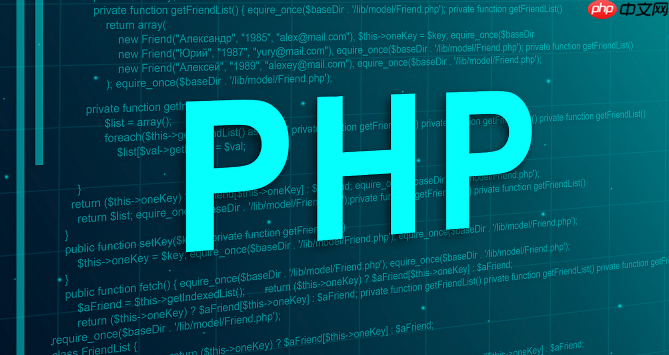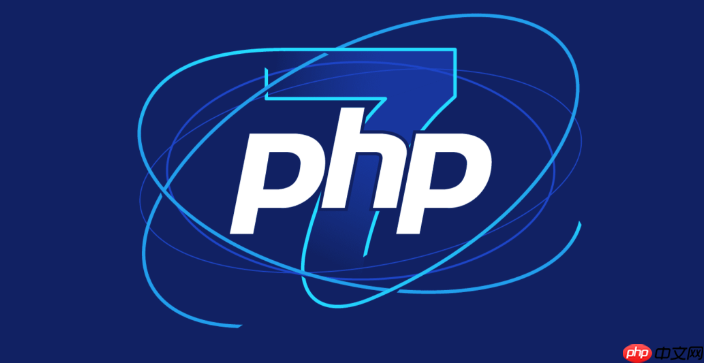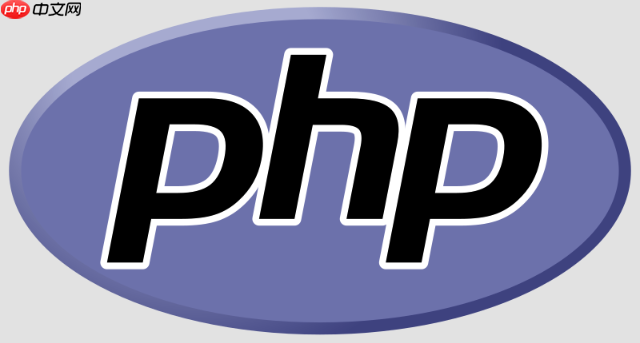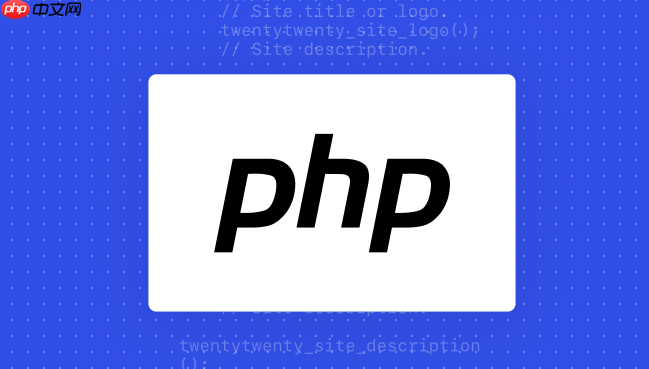 Backend Development
Backend Development
 PHP Tutorial
PHP Tutorial
 How to develop AI intelligent form system with PHP PHP intelligent form design and analysis
How to develop AI intelligent form system with PHP PHP intelligent form design and analysis
How to develop AI intelligent form system with PHP PHP intelligent form design and analysis
When choosing a suitable PHP framework, you need to consider comprehensively according to project needs: Laravel is suitable for rapid development and provides Eloquent ORM and Blade template engines, which are convenient for database operation and dynamic form rendering; Symfony is more flexible and suitable for complex systems; CodeIgniter is lightweight and suitable for simple applications with high performance requirements. 2. To ensure the accuracy of AI models, we need to start with high-quality data training, reasonable selection of evaluation indicators (such as accuracy, recall, F1 value), regular performance evaluation and model tuning, and ensure code quality through unit testing and integration testing, while continuously monitoring the input data to prevent data drift. 3. A number of measures are required to protect user privacy: encrypted storage of sensitive data (such as AES algorithm), implement data desensitization processing, strictly control data access rights, conduct regular security audits, and comply with international privacy protection standards such as GDPR to ensure system compliance and security. Ultimately, an intelligent, efficient and secure AI-driven form system is realized.

The core of developing an AI intelligent form system with PHP is to use PHP to process form data and combine AI algorithms for intelligent analysis and optimization. This is not just a simple form submission and storage process, but rather allows the form to dynamically adjust the form structure, verification rules, and even predict user intentions based on user input, historical data and other information.

Solution:
-
Data collection and storage:

- Use PHP to receive the data submitted in the form and perform preliminary verification (for example: required checks, data type verification).
- Store data into a database, such as MySQL. The table structure design should take into account subsequent AI analysis needs, such as: recording the submission time, user ID, device information, etc.
- Consider using an ORM framework (such as Laravel's Eloquent) to simplify database operations.
-
AI model integration:
- Select the right AI model: Select the right AI model according to the application scenario of the form. For example:
- Prediction model: Predict options that users may be interested in, or predict whether the user will complete the form.
- Recommended model: Recommend appropriate options based on user historical data.
- Natural Language Processing (NLP) model: used to process text input, such as: automatic error correction, sentiment analysis.
- Model training and deployment: Use languages such as Python to train AI models and deploy them to the server. You can use frameworks such as Flask or FastAPI to build API interfaces for PHP calls.
- PHP calls AI model: Use PHP's
curlfunction or Guzzle HTTP client to call the API interface of the AI model to pass form data to the model for analysis.
- Select the right AI model: Select the right AI model according to the application scenario of the form. For example:
-
Dynamic form generation:

- Define form structure: Use JSON or XML formats to define the structure of the form, including field types, verification rules, options, etc.
- Dynamically adjust the form according to the AI analysis results: dynamically adjust the structure of the form according to the analysis results of the AI model. For example:
- Hide or show fields: Hide or show certain fields based on user historical data or current input.
- Adjust verification rules: Adjust verification rules based on user input, such as: relax or strengthen verification of certain fields.
- Dynamic generation options: Dynamic generation options based on user input, for example: search for related options based on keywords entered by users.
- Front-end rendering: Use JavaScript frameworks (such as React, Vue.js, or Angular) to render forms dynamically based on the form structure.
-
User behavior tracking:
- Record user behavior: Use JavaScript to track user behavior, such as: which fields the user stays in for a long time, which fields the user has modified, which options the user has clicked, etc.
- Send user behavior data to the server: Use AJAX to send user behavior data to the server.
- Store user behavior data: Store user behavior data in a database for subsequent AI model training and optimization.
-
Feedback loop:
- Collect user feedback: Collect user feedback on the form, such as: whether the user thinks the form is easy to use, whether the user thinks the form content is useful, etc.
- Analyze user feedback: Analyze user feedback and find out the shortcomings of the form.
- Optimize forms: Continuously optimize the structure and function of the form based on user feedback and analysis results of AI models.
How to choose the right PHP framework to develop AI intelligent form system?
When choosing a PHP framework, consider the ease of use, performance, scalability, and community support of the framework. Laravel and Symfony are two very popular choices. Laravel's Eloquent ORM simplifies database operations, and the Blade template engine can easily generate dynamic forms. Symfony is more flexible and suitable for building complex applications. In addition, CodeIgniter is also a lightweight choice, suitable for rapid development. Which framework to choose depends on your project needs and personal preferences.
How to ensure the accuracy and reliability of AI models?
The accuracy and reliability of AI models are key. First, high-quality data is needed for training. Secondly, it is necessary to select appropriate model evaluation indicators, such as: accuracy, recall, F1 value, etc. Then, the performance of the model needs to be evaluated regularly and adjusted according to the evaluation results. In addition, integration testing and unit testing can be used to ensure the code quality of the model. One point that is easy to be ignored is to continuously monitor the input data of the model to prevent data drift from degrading the model performance.
How to protect user privacy and avoid data leakage?
User privacy is crucial. First, the user data must be encrypted and stored, for example: using the AES encryption algorithm. Secondly, the user data should be desensitized, such as: replace sensitive information such as user name and phone number with anonymous identifiers. Then, access to user data is restricted, which can only be accessed by authorized personnel. In addition, regular security audits must be conducted to ensure the security of the system. Consider using privacy protection standards such as GDPR to guide development.
The above is the detailed content of How to develop AI intelligent form system with PHP PHP intelligent form design and analysis. For more information, please follow other related articles on the PHP Chinese website!

Hot AI Tools

Undress AI Tool
Undress images for free

Undresser.AI Undress
AI-powered app for creating realistic nude photos

AI Clothes Remover
Online AI tool for removing clothes from photos.

Clothoff.io
AI clothes remover

Video Face Swap
Swap faces in any video effortlessly with our completely free AI face swap tool!

Hot Article

Hot Tools

Notepad++7.3.1
Easy-to-use and free code editor

SublimeText3 Chinese version
Chinese version, very easy to use

Zend Studio 13.0.1
Powerful PHP integrated development environment

Dreamweaver CS6
Visual web development tools

SublimeText3 Mac version
God-level code editing software (SublimeText3)
 How to use 5,000 yuan to earn 500,000 yuan in the currency circle?
Aug 07, 2025 pm 08:42 PM
How to use 5,000 yuan to earn 500,000 yuan in the currency circle?
Aug 07, 2025 pm 08:42 PM
In the field of digital currency, a full range of variables and opportunities, increasing the principal of 5,000 to 500,000 means that one hundred times the asset appreciation needs to be achieved. This is not a simple math game, but a comprehensive test involving cognition, strategy, mentality and execution. It requires participants not to rely solely on luck, but also to have keen market insight and extraordinary risk management capabilities.
 What is Bitcoin (BTC)? A brief introduction to what is Bitcoin
Aug 07, 2025 pm 10:48 PM
What is Bitcoin (BTC)? A brief introduction to what is Bitcoin
Aug 07, 2025 pm 10:48 PM
Bitcoin (BTC) is a digital asset created and run based on cryptography principles. It does not rely on specific central institutions, such as banks or governments, to issue and manage. Its concept was first proposed in 2008 by an individual or group named "Satoshi Nakamoto" in a paper titled "Bitcoin: A peer-to-peer electronic cash system."
 SOL price trend forecast: Will it explode again in 2025?
Aug 07, 2025 pm 08:06 PM
SOL price trend forecast: Will it explode again in 2025?
Aug 07, 2025 pm 08:06 PM
Yes, SOL may explode again in 2025. 1) Technology upgrades such as Firedancer launch, which is expected to increase TPS to one million level; 2) New DePIN and AI narratives promote ecological development; 3) On-chain data continues to recover, TVL exceeds US$2 billion; 4) Institutional funds return combined with ETF expectations; 5) If fundamentals and market sentiment cooperate, the price is expected to hit US$250, but you need to be wary of the history of downtime, intensified competition and risk of token selling pressure. Investors should build positions in batches and combine on-chain data dynamic adjustment strategies. The final outbreak depends on the synergistic effect of technology implementation, ecological activity and capital resonance.
 What are stablecoins? What are the top 10 stablecoins in market value?
Aug 07, 2025 pm 10:57 PM
What are stablecoins? What are the top 10 stablecoins in market value?
Aug 07, 2025 pm 10:57 PM
Stable coins are cryptocurrencies whose value is linked to stable assets such as the US dollar or gold. They aim to solve the problem of large price fluctuations in currencies such as Bitcoin. They achieve price stability through an anchoring mechanism and are mainly divided into three categories: 1. Stable coins with legal currency collateral, such as USDT and USDC, are supported by US dollar reserves, and users can exchange 1:1; 2. Stable coins with crypto assets collateral, such as DAI and crvUSD, are generated by over-collateralized digital assets such as Ethereum, and have decentralized characteristics; 3. Algorithmic stable coins, such as USDD, rely on algorithms to adjust supply and demand to maintain currency value, and have no direct asset collateral, and are at a high risk. The top 10 stablecoins currently ranked in market capitalization include: 1. USDT, the earliest and most liquid dollar stablecoins; 2. USDC, to comply with and
 How to make 300,000 yuan with 3,000 yuan in the currency circle? Ultimate actual combat
Aug 07, 2025 pm 08:36 PM
How to make 300,000 yuan with 3,000 yuan in the currency circle? Ultimate actual combat
Aug 07, 2025 pm 08:36 PM
From three thousand to three hundred thousand means seeking a hundred times the reward. This is not a fantasy in the crypto world, but it requires the executor to have a very high level of cognition, a tough mindset and precise operation. This is not a comfortable road, but a high-risk and high-reward game. The path to this goal requires careful design and strict implementation.
 edge pdf viewer not working
Aug 07, 2025 pm 04:36 PM
edge pdf viewer not working
Aug 07, 2025 pm 04:36 PM
TestthePDFinanotherapptodetermineiftheissueiswiththefileorEdge.2.Enablethebuilt-inPDFviewerbyturningoff"AlwaysopenPDFfilesexternally"and"DownloadPDFfiles"inEdgesettings.3.Clearbrowsingdataincludingcookiesandcachedfilestoresolveren
 How to make tens of millions with tens of thousands of principal in the currency circle? How can a low principal counterattack in the currency circle?
Aug 07, 2025 pm 08:33 PM
How to make tens of millions with tens of thousands of principal in the currency circle? How can a low principal counterattack in the currency circle?
Aug 07, 2025 pm 08:33 PM
In a field full of variables and opportunities, the narrative of earning tens of millions of dollars with tens of thousands of principal is a dream in the minds of many participants. This process is not a simple investment, but rather an extreme challenge that combines cognition, luck, strategy and courage. It requires participants to reach a very profound level of understanding of the market and to be able to withstand risks and fluctuations that ordinary people cannot imagine. To achieve such a leap means to capture the growth opportunities at the thousand times level in the right time and in the right way.
 Cryptocurrencies worth watching in 2025: 5 cryptocurrencies not to be missed
Aug 07, 2025 pm 11:15 PM
Cryptocurrencies worth watching in 2025: 5 cryptocurrencies not to be missed
Aug 07, 2025 pm 11:15 PM
Bitcoin (BTC) consolidates its "digital gold" position due to the halving effect and spot ETFs; 2. Ethereum (ETH) maintains its leading position in smart contract platforms with the PoS mechanism, deflation model and continuous upgrades; 3. Solana (SOL) has recovered and expanded rapidly in the fields of DePIN, Meme and DeFi with its high performance and low cost; 4. BNB relies on the strong support of the Binance ecosystem to maintain high demand in transactions, Launchpad and on-chain applications; 5. Render (RNDR) combines AI and blockchain, uses decentralized GPU computing power to meet the growing rendering needs, becoming a potential project for the integration of AI and the metaverse; these five crypto products








